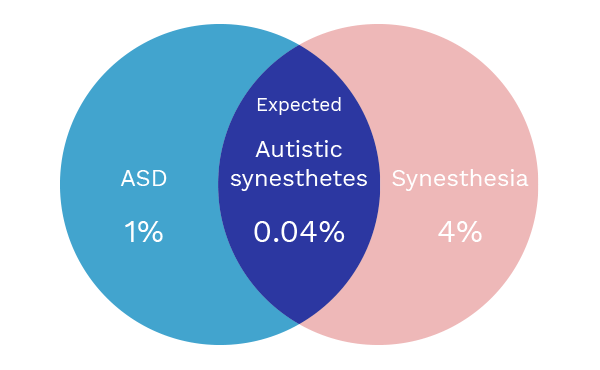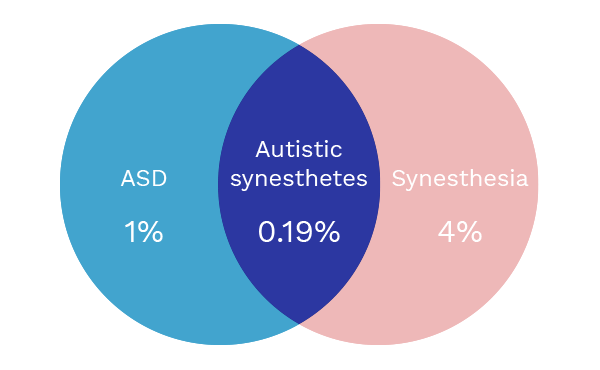It’s not only numbers that I see in colors. Words too, for me,
have colors and emotions and textures.[1]Different ways of knowing | Daniel Tammet | TED — Daniel Tammet
Synesthesia
Synesthesia occurs when the stimulation of one sensory modality automatically evokes a perception in another unstimulated modality.[2]Is synaesthesia more common in autism? In other words, one sensory experience activates another sensory experience. So synesthesia is defined as a joining of the senses, where for instance music may trigger colours, or words may trigger tastes.
At first glance, synesthesia and autism may appear to have nothing to do with each other. In this post, I will explain why the two actually have a significant connection.
Prevalence of synesthesia
Research has indicated that autistic people have a greater than average chance of having synesthesia; while autism occurs in approximately 1% (to 2.5%) of the population and synesthesia occurs in 4% of the population, the co-occurrence of the conditions would statistically be 0.04% (4 in 10,000 people).

However, synesthesia was diagnosed in an impressive 19% of autistic people, compared to 4% in the general population.[3]Is synaesthesia more common in autism?

Sensory sensitivity
Research has found significant phenotypic and genetic overlap between synesthesia and absolute pitch, a trait that has also been reported to occur at increased frequency in autistic people.[4]Is synaesthesia more common in autism?
Furthermore, experts in both conditions published in the journal Scientific Reports found that both synesthetes and autistics experience heightened sensory sensitivity.[5]Sensory links between autism and synesthesia pinpointed
Most common types
Research has found that in people who are both autistic and synesthetes, the most common types were those known as:[6]Synesthesia Linked to Autism | PsychCentral
- Chromesthesia or sound–color synesthesia (when a sound triggers a visual experience of color).
- Grapheme–color synesthesia (seeing black letters as colored).
Other common types of synesthesia were seeing color when exposed to tastes or smells.[7]Synesthesia Linked to Autism | PsychCentral
Hyperconnectivity
Researchers have sought the reason behind this significant increase in synesthesia in autistic people, and found an approximate answer.
Both conditions involve atypical neural connectivity and indeed neuroimaging studies confirm that synesthesia is associated with differences in brain structure and/or function. The hyperconnectivity hypothesis proposes that people with synesthesia have excessive neural connections between different regions. These connections are either diminished or absent in neurotypical individuals.[8]Is synaesthesia more common in autism?
Four mechanisms have been proposed to account for neural hyperconnectivity:
- Faulty axonal pruning
- Differences in axon guidance
- Disinhibition
- Atypical border formation
I will highlight a few of these and their connection to synesthesia in a moment. In any case, hyperconnectivity can result in certain deficits, but also in certain advantages, such as synesthesia. Autism seems to be largely characterized by these deficits and advantages. For more information in (hyper)connectivity in the autistic brain, have a look at our following post:
Autistic brain differences pt. 1 – Connectivity
White matter connections
Both autism and synesthesia are characterized by increased white matter tracts connecting different parts of the brain. Some of these connections transverse the entire brain from the frontal cortex back to the occipital lobe, while other white matter tracts connect adjacent regions. The autistic brain also shows an increased volume of short-distance white matter connections due to a proliferation of synaptogenesis (the creation of new connections), or a failure in the pruning-out of these synaptic connections during childhood.
Synesthetes also show an increased density of white matter—especially in the sensory regions of the condition. For example, grapheme–color synesthesia has increased connections between the region responsible for color perception, and the visual word–form area.[9]Can Synesthesia in Autism Lead to Savantism? | Scientific American
For more information on white matter volumes and other brain differences, have a look at these two posts from our autistic brain differences series:
Autistic brain differences pt. 4 – Cerebrum
Autistic brain differences pt. 5 – Cerebellum
Synaptic pruning
Synesthesia is quite common in brains that show a lack of synaptic pruning[10]Synesthesia: opening the doors of perception | Dartmouth Undergraduate Journal of Science causing anomalous patterns of connectivity.[11]The immune hypothesis of synesthesia Some forms of synesthesia (such as grapheme–color synesthesia) emerge due to cross-activity, where clusters of neurons are activated at once. Effectively more neurons than necessary are being activated, which can give rise to combining of senses that a brain with fewer neuronal connections would likely not experience. For more information on what synaptic pruning is and its connection to synesthesia, read our post below.
Synaptic growth, synesthesia & savant abilities
Other forms of synesthesia (such as lexical–gustatory synesthesia) emerge from increased connectivity between adjacent regions in the brain, thus connecting senses as well. Note that although synesthesia may seem extraordinary, it’s not necessarily a beneficial or wanted experience; it can be a distraction,[12]A Mental Condition Can Make People Seem to Spew Ticker Tape | Gizmodo it can drastically undermine one’s life, and can even be painful, as is often the case in mirror–touch synesthesia.
Synesthesia models
As we just saw, different forms of synesthesia emerge from different brain structures. As such, there are two main models that attempt to explain synesthesia, and they seemingly contradict each other.
Cross-activation model
In 2001, V. S. Ramachandran and Edward M. Hubbard introduced the cross-activation model of grapheme–colour synaesthesia, which suggests that hyperconnectivity between functional areas of the cerebral cortex allows activation in one cortical area (for example, the auditory cortex) to directly trigger activation in another (say, the visual cortex).[13]Psychophysical investigations into the neural basis of synaesthesia[14]The cross-activation theory at 10 Diffusion tensor imaging (DTI) for example shows that hyperconnectivity is indeed a feature of the synesthetic brain.[15]Increased structural connectivity in grapheme-color synesthesia[16]The immune hypothesis of synesthesia
Disinhibited feedback model
Also in 2001, (something synesthetic might have been in the air at the time) Peter Grossenbacher and Christopher T. Lovelace introduced the disinhibited feedback model, which proposes that synesthetic sensations are caused by disinhibited feedback from higher cortical areas (for instance, in the parietal lobe), which then fails to suppress (arguably) “non-relevant” activation from lower cortical areas.[17]Mechanisms of synesthesia: cognitive and physiological constraints This type of disinhibited feedback may result from excessive activity of excitatory neurons within the delicate balance between both excitatory and inhibitory neurons in the brain, as a 2011 study from Ramachandran, Hubbard, and David Brang shows.[18]The cross-activation theory at 10[19]The immune hypothesis of synesthesia
It seems the two models are not mutually exclusive, but both hold; while connectivity models propose hyperconnectivity as the underlying mechanism for synesthesia, feedback models might allow altered connectivity as an indirect consequence of disinhibited feedback.[20]The immune hypothesis of synesthesia
So there you go. The local hyperconnectivity in autistic brains can cause synesthetic experiences due to cross-connectivity. But synesthesia can also emerge from feedback from excitatory neurons due to a lack of suppression (i.e. sensory filtering).
Either way, it seems the autistic brain features structures that often give rise to synesthetic experiences. No wonder then that 1 out of every 5 autistic people have synesthesia.
Comments
Let us know what you think!